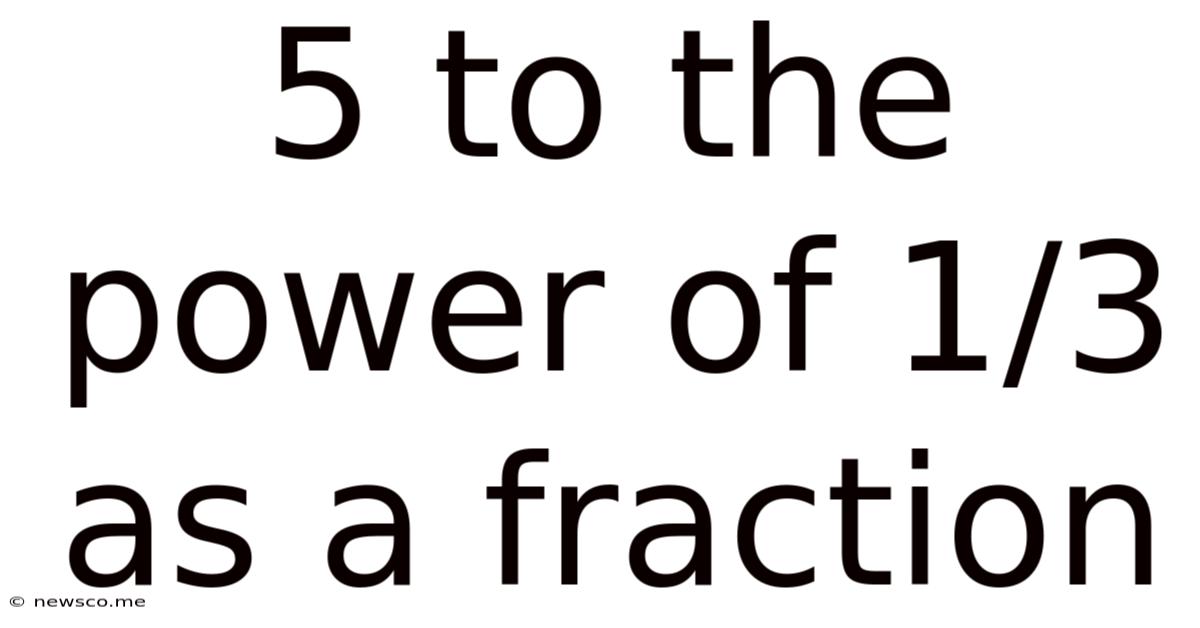5 To The Power Of 1/3 As A Fraction
News Co
May 08, 2025 · 5 min read

Table of Contents
5 to the Power of 1/3 as a Fraction: A Comprehensive Exploration
Understanding exponents and their application to fractions can sometimes feel daunting. This article delves deep into the seemingly simple problem of calculating 5 to the power of 1/3 as a fraction, exploring the underlying mathematical principles, various approaches to solving it, and offering practical examples to solidify your understanding. We’ll go beyond a simple numerical answer and uncover the conceptual beauty behind this mathematical expression.
Understanding Exponents and Fractional Exponents
Before tackling the specific problem, let's refresh our understanding of exponents. An exponent, also known as a power or index, indicates how many times a number (the base) is multiplied by itself. For example, 5² (5 to the power of 2) means 5 * 5 = 25. Similarly, 5³ (5 to the power of 3) means 5 * 5 * 5 = 125.
Now, let's introduce fractional exponents. A fractional exponent represents a root. The denominator of the fraction indicates the type of root, while the numerator indicates the power to which the root is raised. For example:
- x<sup>1/2</sup> is the square root of x (√x)
- x<sup>1/3</sup> is the cube root of x (∛x)
- x<sup>m/n</sup> is the nth root of x raised to the power of m, or (<sup>n</sup>√x)<sup>m</sup>
Therefore, 5<sup>1/3</sup> signifies the cube root of 5 (∛5). This means we're looking for a number that, when multiplied by itself three times, equals 5.
Calculating 5 to the Power of 1/3 as a Fraction: The Challenge
The challenge lies in expressing the cube root of 5 as a fraction. Unlike the cube root of perfect cubes (like 8 or 27), the cube root of 5 is an irrational number. This means it cannot be expressed as a simple fraction (a ratio of two integers). It's a decimal number that goes on infinitely without repeating.
However, we can approximate 5<sup>1/3</sup> as a fraction. The accuracy of this approximation depends on the level of precision required.
Approximating 5<sup>1/3</sup> using Different Methods
Several methods can help us approximate the cube root of 5 as a fraction:
1. Numerical Approximation using a Calculator
The simplest way to find an approximate value is using a calculator. Most calculators have a cube root function (often denoted as ³√ or x<sup>(1/3)</sup>). This will give you a decimal approximation, which can then be converted to a fraction. The calculator will show a decimal value close to 1.70997594668. To convert this to a fraction, we would need to round it to a manageable decimal, e.g., 1.71. This can then be converted into an approximate fraction through trial and error or using continued fractions, although this will lose accuracy.
2. The Babylonian Method (Newton-Raphson Method)
The Babylonian method is an iterative algorithm for approximating the square root of a number, but it can be adapted for cube roots. It works by repeatedly refining an initial guess until the desired accuracy is achieved. The formula for the cube root is:
x<sub>n+1</sub> = (2x<sub>n</sub> + a/x<sub>n</sub>²) / 3
where:
- x<sub>n</sub> is the nth approximation
- x<sub>n+1</sub> is the (n+1)th approximation
- a is the number for which we want to find the cube root (in our case, a = 5)
Starting with an initial guess (e.g., x<sub>0</sub> = 2), you can iteratively apply this formula to get increasingly closer approximations. While this yields a precise decimal value, converting this to a fraction remains an approximation.
3. Using Continued Fractions
Continued fractions offer a way to represent irrational numbers as a sequence of integers. While not directly yielding a fraction in the traditional sense, it provides a rational approximation that can be refined to higher levels of accuracy. This method is complex but yields highly accurate rational approximations.
4. Understanding the Limitations of Fractional Representation
It's crucial to acknowledge the limitations. Since 5<sup>1/3</sup> is irrational, any fractional representation will be an approximation. The closer the approximation, the more complex the fraction will become. There is no single "perfect" fraction that represents the cube root of 5.
Practical Applications and Examples
Understanding fractional exponents and their application, even in approximating irrational numbers, has practical significance across several fields:
- Engineering: Calculating volumes and dimensions.
- Physics: Solving problems involving forces and energy.
- Finance: Compound interest calculations.
- Computer Science: Numerical algorithms and approximations.
Consider the example of calculating the side length of a cube with a volume of 5 cubic units. The side length would be 5<sup>1/3</sup>. Using a calculator or approximation methods, we'd find a value near 1.71, representing the approximate side length in appropriate units.
Conclusion: Embracing Approximation in Mathematical Calculations
While we can't express 5<sup>1/3</sup> as an exact fraction, we can effectively approximate it using several methods. This exploration highlights the importance of understanding the nature of irrational numbers and embracing approximation techniques when necessary. The key takeaway is not just finding a numerical answer but grasping the underlying mathematical concepts and appreciating the limitations of representing irrational numbers with fractions. Whether you employ a calculator, the Babylonian method, or continued fractions, the essence lies in the process of approximating and understanding the inherent nature of the mathematical problem at hand. Remember to always choose the method that best suits your needs in terms of accuracy and complexity.
Latest Posts
Related Post
Thank you for visiting our website which covers about 5 To The Power Of 1/3 As A Fraction . We hope the information provided has been useful to you. Feel free to contact us if you have any questions or need further assistance. See you next time and don't miss to bookmark.